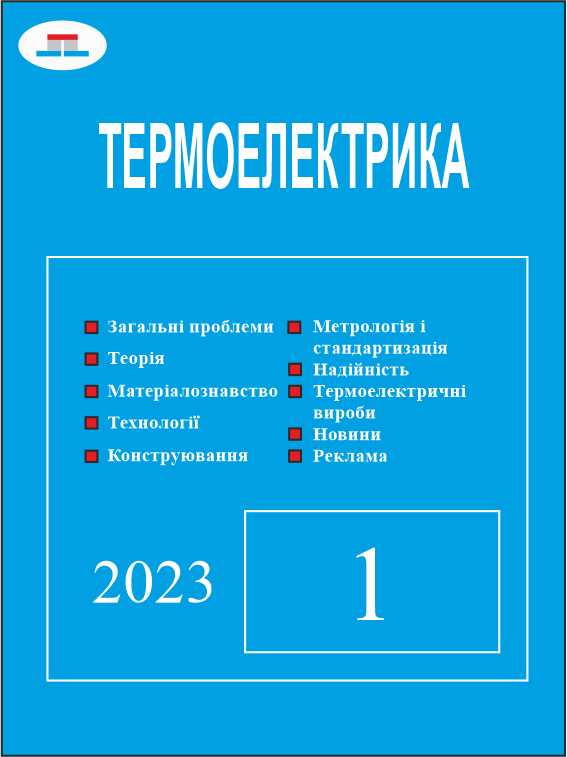Фазова стабільність термоелектричних тонких плівок ZnSb-SnTe
DOI:
https://doi.org/10.63527/1607-8829-2023-1-14-23Ключові слова:
тонкі плівки, термоелектричні матеріали, спінодальний розпад, фазова стабільністьАнотація
У статті теоретично досліджено фазову стабільність тонких плівок псевдобінарних напівпровідникових сплавів ZnSb-SnTe. Отримані T – x фазові діаграми дозволили передбачити існування широкого інтервалу незмішуваності. Врахування малих внутрішніх напружень та впливу кварцової підкладки не призвело до істотних змін фазової діаграми залежно від товщини плівки. Показано, що процеси спінодального розпаду, спричинені відпалом при T = 225 °C у сплавах (ZnSb)1-х(SnTe)х при x = 0.27, призводять до мікроструктурної еволюції з утворенням виділень металевої фази SnSb. Цей факт добре узгоджується з експериментальними дослідженнями розглянутих тонких плівок і є причиною різкого зростання коефіцієнта потужності до 3383 мкВт/(м-1К-1) при 300 °C. Описані процеси рекристалізації є основним механізмом високих термоелектричних характеристик цього матеріалу. Бібл. 20, рис. 3.
The article theoretically studies the phase stability of thin films of pseudobinary semiconductor alloys ZnSb–SnTe. The obtained T – x phase diagrams made it possible to predict the existence of a wide miscibility gap. Taking into account small internal stresses and the influence of the quartz substrate did not lead to significant changes in the phase diagram depending on the film thickness. It has been shown that spinodal decomposition processes caused by annealing at T = 225 °C in (ZnSb)1-х(SnTe)х alloys at x = 0.27 lead to microstructural evolution with the formation of precipitates of the SnSb metal phase. This fact is in good agreement with the experimental studies of the thin films considered and is the reason for the sharp increase in the power factor to 3383 μWm-1K-1 at 300 °C. The described recrystallization processes are the main mechanism for the high thermoelectric characteristics of this material. Bibl. 20, Fig. 3.
Посилання
Anatychuk L. I. and Vikhor L. N. (2012). Functionally Graded Thermoelectric Materials. Chernistvi: Institute of Thermoelectricity. J.Thermoelectricity, 4.
Marciá-Barber E. (2015). Thermoelectric Materials. Advances and Applications. New York Taylor & Francis Group, Pan Stanford.
Urban J. J., Menon A. K., Tian Z., Jain A., Hippalgaonkar K. New horizons in thermoelectric materials: Correlated electrons, organic transport, machine learning, and more. J. Appl. Phys. 2019. 125(5). 180902.
Li C., Jiang F., Liu C., Liu P., Xu J. (2019)Present and future thermoelectric materials toward wearable energy harvesting, Applied Materials Today. 15(6). 543 – 557 p.
Deibuk V. G. (2017). Thermodynamic stability of thin CdZnSb epitaxial films, J. Thermoelectricity, 1. P.44 – 52.
Li X, , Cai K., Gao M., Du Y., Shen S. (2021). Recent advances in flexible thermoelectric films and devices, Nano Energy. 89A(11). 106309.
Wang G., Zhang Y., Lotnyk A., Shi H., Chen C. (2021). High thermoelectric performance in ZnSb-SnTe pseudo-binary materials, Scripta Materialia. 194(3) 113670.
Chen A.-B., Sher A. (2011). Semiconductor Alloys: Physics and Materials Engineering. New York, Plenum Press,.
Stringfellow G. B. (2021). Epitaxial growth of metastable semiconductor alloys, J. Cryst. Growth. 564(6). 126065.
Landau L. D., and Lifshitz E.M. (2005). Theory of Elasticity, Course of Theoretical Physics, Vol. 7. London, Elsevier.
Zhang Y., Sun J., Shuai J., Tang X., Tan G. (2021). Lead-free SnTe-based compounds as advanced thermoelectrics, Materials Today Physics. 19(7). 100405.
Ronneberger I., Zanolli Z., Wuttig M., Mazzarello R. (2020). Changes of Structure and Bonding with Thickness in Chalcogenide Thin Films, Adv. Mater. 32(8). 2001033.
Hsu S.-C., Hong J.-Y., Chen C.-L., et al. (2021). The structures and thermoelectric properties of Zn-Sb alloy films fabricated by electron beam evaporation through an ion beam assisted deposition, Applied Surface Science. 540(2). 148264.
Sarkar P., Pandey J., AnsarH. S. et al., (2020.) Environment friendly SnTe thermoelectrics: Material to device, AIP Conf. Proc. 2265(11). 030628.
Beanland R. , Dunstan D. J. & Goodhew P. J. (1996). Plastic relaxation and relaxed buffer layers for semiconductor epitaxy, Advances in Physics. 45(1). 87 – 146 p.
Dunstan D. J. (2012). Critical Thickness Theory Applied to Micromechanical Testing, Adv. Eng. Mater., 14(3). 942 - 947 p..
Liu M., Ruan H., Zhang L., et al, (2012). Effects of misfit dislocation and film-thickness on the residual stresses in epitaxial thin film systems: Experimental analysis and modeling, Journal of Materials Research. 27(11). 2737 – 2745 p.
The Materials Project. https://next-gen.materialsproject.org/ (accessed January 11, 2024)
Yazawa K., Bahk J.-H., Shakouri A. (2021). Thermoelectric Energy Conversion Devices and Systems. WSPC Series in Advanced Integration and Packing. Singapore, World Scientific.
Ohkubo I., Murata M., Lima M. S. L., et al. (2022). Miniaturized in-plane π-type thermoelectric device composed of a II–IV semiconductor thin film prepared by microfabrication, Materials Today Energy. 28(1). 101075.




